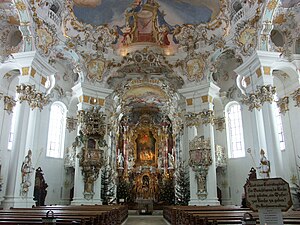Barroque
|
Baldachino of St. Peter's Basilica by Bernini; Louis XIV by Bernini;The Toilet of Venus by François Boucher; Wieskirche, Bavaria
|
|
| Years active | 17th-18th century |
|---|---|
| Country | Europe and Latin America |
The Baroque (US: /bəˈroʊk/ or UK: /bəˈrɒk/) is a highly ornate and often extravagant style of architecture, art and music that flourished in Europe from the early 17th until the late 18th century. It followed the Renaissance style and preceded the Neoclassical style. It was encouraged by the Catholic Church as a means to counter the simplicity and austerity of Protestant architecture, art and music. The baroque style used contrast, movement, exuberant detail, grandeur and surprise to achieve a sense of awe. The style began in the first third of the 17th century in Rome, then spread rapidly to France, northern Italy, Spain and Portugal, then to Austria and southern Germany. By the 1730s, it had evolved into an even more flamboyant variant, called rocaille or Rococo, which appeared in France and central Europe until the late 18th century.
The word baroque was a Portuguese term for a pearl (barocco) with an irregular shape. Cognates for the term in other Romance languages include: barroco in Portuguese, barrueco in Spanish, and barocco in Italian. It was used in French to describe pearls in a 1531 inventory of Charles V's treasures.
In the 18th century, the term was usually used to describe music. In an anonymous satirical review of the première of Jean-Philippe Rameau's Hippolyte et Aricie in October 1733, which was printed in the Mercure de France in May 1734, the critic wrote that the novelty in this opera was "du barocque", complaining that the music lacked coherent melody, was unsparing with dissonances, constantly changed key and meter, and speedily ran through every compositional device.
...
Wikipedia




